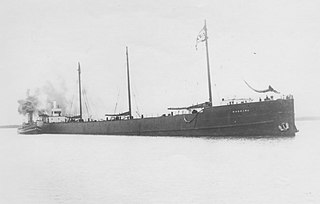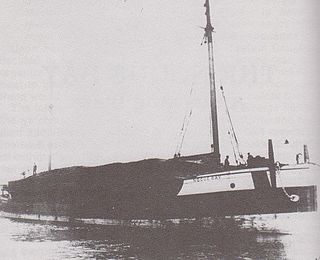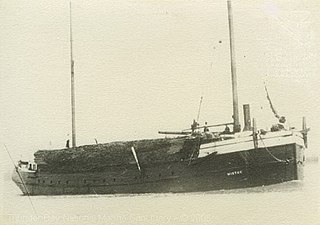Related Research Articles

A scow is a smaller type of barge. Some scows are rigged as sailing scows. In the 19th and early 20th centuries, scows carried cargo in coastal waters and inland waterways, having an advantage for navigating shallow water or small harbours. Scows were in common use in the American Great Lakes and other parts of the U.S., Canada, southern England, and New Zealand. In modern times their main purpose is for recreation and racing.

A staysail ("stays'l") is a fore-and-aft rigged sail whose luff can be affixed to a stay running forward from a mast to the deck, the bowsprit, or to another mast.

C.A. Thayer is a schooner built in 1895 near Eureka, California. The schooner is now preserved at the San Francisco Maritime National Historical Park. She is one of the last survivors of the sailing schooners in the West coast lumber trade to San Francisco from Washington, Oregon, and Northern California. She was designated a National Historic Landmark on 13 November 1966.

Alma is an 1891-built scow schooner, which is now preserved as a National Historic Landmark at the San Francisco Maritime National Historical Park in San Francisco, California.
The United States Lighthouse Tender Warrington was a lighthouse tender which served on the Great Lakes. She was built as a steam barge in 1868, and began life under the name Henry Warrington. Rechristened simply Warrington, she began government service late in 1870, and was soon pressed into service supporting the construction of the Spectacle Reef Light on Lake Huron. On one of her trips across the lake, during a late-fall storm, she encountered the schooner Darien, which was breaking up on the shore; the Warrington's crew managed to turn towards the wounded vessel and rescued her entire crew.

Madeira was a schooner barge that sank off the coast of Minnesota in Lake Superior on November 28, 1905. A schooner barge is a type of ship that functions like a barge, in that it is towed by a steamship, but also has sails like a schooner. This type of ship evolved from wooden sailing ships that were cut down into barges and towed behind wooden steamships, a practice which originated in the late 1880s in coastal areas. This design was commonly used in the Great Lakes for transporting grain, iron ore, and other products.

Wapama, also known as Tongass, was a vessel last located in Richmond, California. She was the last surviving example of some 225 wooden steam schooners that served the lumber trade and other coastal services along the Pacific Coast of the United States. She was managed by the National Park Service at San Francisco Maritime National Historical Park until dismantled in August 2013.

Samuel P. Ely is a shipwreck in Two Harbors, Minnesota listed on the National Register of Historic Places. She was a schooner that sailed the Great Lakes carrying iron ore, coal, and other bulk freight. She was built in 1869 and was a fairly typical example of the 200-foot schooner built in the 1870s, though she was reinforced for the demands of carrying iron ore.
Consort is a nautical term for unpowered Great Lakes vessels, usually a fully loaded schooner barge or steamer barge, towed by a larger steamer that would often tow more than one barge. The consort system was used in the Great Lakes from the 1860s to around 1920. Mariner and historian Mark Thompson wrote that the unpowered barges were "uninspected vessels" not regulated by the marine safety laws. He reported that between 1870 and 1940, the dangerous practice of towing unpowered vessels resulted in many of the most serious groundings when they broke loose or were cut loose during storms.

SS Myron was a wooden steamship built in 1888. She spent her 31-year career as lumber hooker, towing schooner barges on the Great Lakes. She sank in 1919, in a Lake Superior November gale. All of her 17 crew members were killed but her captain survived. He was found drifting on wreckage near Ile Parisienne. Her tow, the Miztec, survived. Myron defied the adage that Lake Superior "seldom gives up her dead" when all 17 crewmembers were found frozen to death wearing their life jackets. Local residents chopped eight of Myron's sailors from the ice on the shore of Whitefish Bay and buried them at the Mission Hill Cemetery in Bay Mills Township, Michigan.

The Miztec was built as a 3-masted schooner in 1890. She was later converted to a schooner barge and served as a consort for lumber hookers on the Great Lakes. She escaped destruction in a severe 1919 storm that sank her longtime companion, the SS Myron, only to sink on the traditional day of bad luck, Friday the 13th, 1921, with the loss of all hands. She came to rest on Lake Superior's bottom off Whitefish Point near the Myron.

Noquebay was a wooden schooner barge that sank in Lake Superior in Chequamegon Bay off Stockton Island. The wreck site was added to the National Register of Historic Places in 1992.
Gallinipper was a schooner that sank in Lake Michigan off the coast of Centerville, Manitowoc County, Wisconsin, United States. In 2010, the shipwreck site was added to the National Register of Historic Places.
Home was a two-masted schooner which sank in Lake Michigan off Centerville in Manitowoc County, Wisconsin, United States, in 1858. In 2010 the shipwreck site was added to the National Register of Historic Places.
The Island City was a schooner that sank in Lake Michigan off the coasts of Mequon, Wisconsin and Port Washington, Wisconsin, United States. On November 10, 2011, the shipwreck site was added to the National Register of Historic Places.
Minnedosa was a four-masted wooden Great Lakes schooner launched in 1890. This was late in the era of sailing ships and it spent its career as a barge, towed by a steam tug. It was lost with its nine crew and passengers and a heavy load of grain in a storm October 20, 1905 on Lake Huron.

A schooner barge is a type of ship; a schooner converted as a barge. Schooner barges originated on the Great Lakes in the 1860s and were in use until World War II, although a few survived into the 1950s.

Antelope was a Great Lakes steamship that later was converted into a schooner barge) and sank in Lake Superior near the Apostle Islands in 1897.

SS Selah Chamberlain was a wooden hulled Great Lakes freighter that sank in Lake Michigan in 1886, 6 miles (10 km) off the coast of Sheboygan, Sheboygan County, Wisconsin, United States after being rammed by the steamer John Pridgeon Jr. with the loss of five lives. On January 7, 2019, the wreck of Selah Chamberlain was listed on the National Register of Historic Places, and was given the reference number 100003288. She was the first shipwreck listed on the National Register of Historic Places in 2019.

SS Plymouth was an American Schooner barge that sank during the Great Lakes Storm of 1913 in Lake Michigan, near St. Martins Island at the mouth of Green Bay, while she was being towed by the tug James H. Martin from Menominee, Michigan, United States to Lake Huron.
References
- ↑
- Boyer, Dwight (1996). Great Stories of the Great Lakes: Thrilling Tales of Tragedy, Humor, and Heroism. Cleveland, Ohio, USA: Freshwater Press, Inc. ISBN 0-912514-49-3.